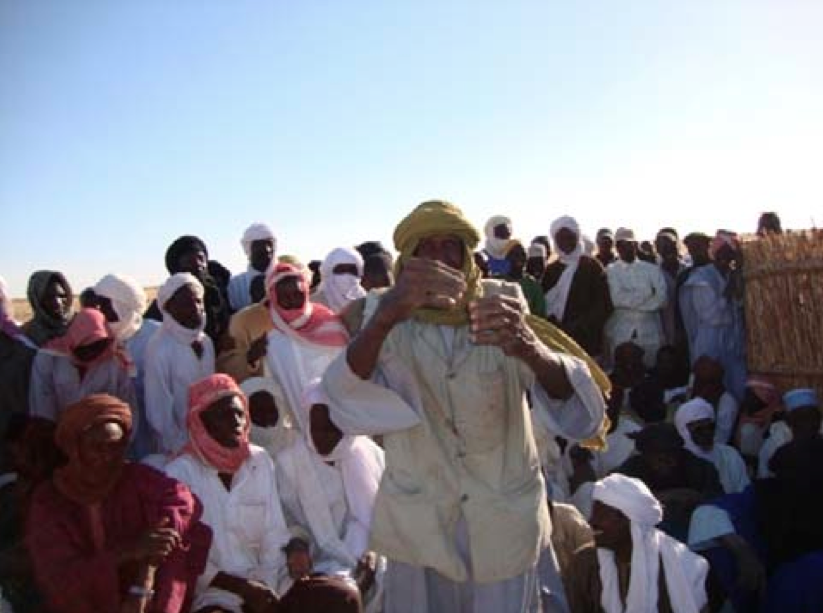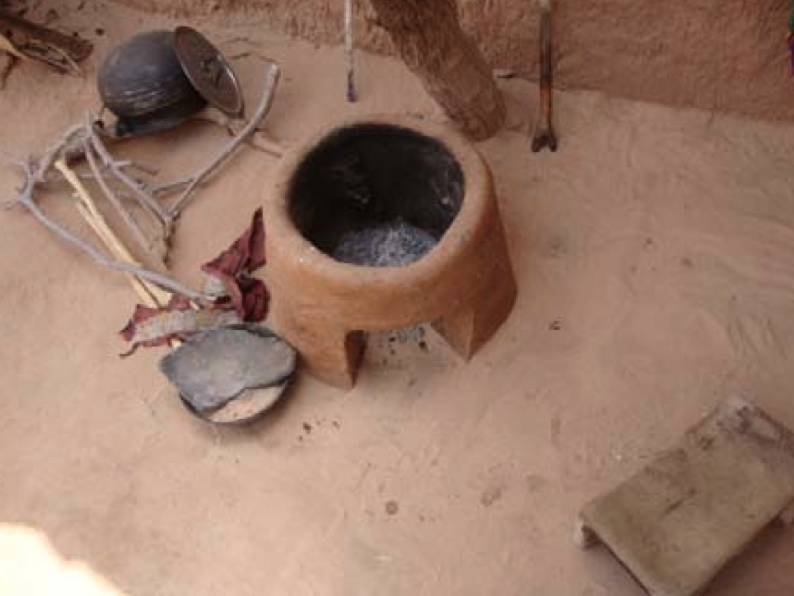CBA Niger: Intensified Agroforestry Practices for Adaptation in Tânout (Yanahi)
Project Overview
The ecosystem zone in the villages of Tamalolo, Tânout, is Sahelian and characterized by dunes, rainy season cultivation lands, gentle slopes (glacis) in the fields, and large pastures and animals. Droughts, extreme temperatures and violent winds—all driven by climate change—have led to grasshopper infestations and brush fires in the past (1974, 1984 and 2005) and continue to have harmful consequences on agriculture, livestock breeding, and ecosystems. This situation has caused many households to become vulnerable, and production does not allow the population to meet their nutritional daily needs. For example, there was no food production in the department of Tanout in 2008 and 2009.
With the help of the CBA Project, community members are using sustainable agroforestry practices and ecosystem protection techniques to improve their farm production, confront food insecurity and adjust to food shortages.
This Community-Based Adaptation project aimed to develop sustainable agroforestry practices to improve food production and reduce climate change-induced ecosystem pressures. The project increased the adaptive capacity of community members by training them to better understand climate change and its associated risks and impacts. It also improved their capacity to self-organize and to pursue their own adaptive measures. Together, these measures make the Tamalolo ecosystem more climate-resilient, improving food security and livelihood conditions.
* This project was part of Niger's Community-Based Adaptation portfolio. *
Project Details
This Community-Based Adaptation project focuses on five villages in Niger’s Tamalolo countryside. With its extreme arid climate and lack of rainfall, this area is particularly vulnerable to the impacts of climate change. The ecosystem zone is Sahelian and characterized by dunes, rainy season cultivation lands, gentle slopes (glacis) in the fields, and large pastures and animals. Droughts, extreme temperatures and violent winds—all driven by climate change—have led to grasshopper infestations and brush fires in the past (1974, 1984 and 2005) and continue to have harmful consequences on agriculture, livestock breeding, and ecosystems.
Due to these consequences, the 745 residents, divided into four ethnic groups (1) Haoussa, (2) Peulh, (3) Touareg, and (4) Kanouri, are repeatedly faced with food shortages and rely on the surrounding plantation for food, including very stunted forest species (mainly spinous shrubs such as Acacia raddiana, Balanites eagyptiacaand Boscia senegalensis [Anza]). As soil degradation continues to worsen, topsoils on arable land are being swept away by the wind, creating glacis zones and sand dunes in the fields. Consequently, rain water does not infiltrate into the ground and cultivation lands are deteriorating (loss of fertility), which leads to very poor agricultural production and constant productivity loss. This situation has caused many households to become vulnerable, and local food production does not allow the population to meet nutritional daily needs. For example, there was no food production in the department of Tanout in 2008 and 2009.
With the help of the CBA Project, community members are using sustainable agroforestry practices and ecosystem protection techniques to improve their farm production, confront food insecurity and adjust to food shortages.
This project focuses on developing sustainable agroforestry practices to improve food production, as well as providing alternative solutions to reduce pressure on ecosystems in the face of the adverse climate change effects. Project activities will implement agroforestry practices adapted to the project zone’s climate conditions, such as tree plantation, village nurseries, and establish mulching on the bare soils and of timothy grass clumps on bare sandy spaces. Sustainable farming techniques, such as cutting, pruning and maintaining young shoots will be promoted in order to reconstitute vegetation cover and protect cultures against violent winds. Environmental patrols will be implemented in order to reduce pressure on ecosystems. Finally, local communities will be trained (with a strong focus on mainstreaming women) on construction techniques and the use of ‘Albarka’ (adobe) fireplaces to save on energy and wood, reducing the pressure on local ecosystems.
Key Results and Outputs
- Conduct information and awareness-raising training sessions for communities on climate change impacts and adjustment strategies; encourage farmers to further disseminate adaptive techniques by training their peers.
- Implement environmental patrols in order to reduce pressure on ecosystems.
- Promote sustainable farming techniques, such as cutting, pruning and maintaining young shoots in order to reconstitute vegetation cover and protect cultures against violent winds.
- Implement agroforestry practices adapted to the project zone’s climate conditions, such as tree plantation, village nurseries, and establish mulching on the bare soils and of timothy grass clumps on bare sandy spaces.
- Train local communities (with a strong focus on women) on construction techniques and the use of ‘Albarka’ (adobe) fireplaces to save on energy and wood, and reduce pressure on the ecosystems.
- Provide fertilizing species for use in fields, stimulate soil fertilization, help reconstitute vegetal cover, and increase food security by improving the resistance of the agro-ecosystems to drought and to threats provoked by climate change.
Reports and Publications
Brochures, Posters, Communications Products
Annual Reports
Project Brief / Fact Sheet
Monitoring and Evaluation
Monitoring and evaluation for community-based adaptation is a new field, and the CBA project is piloting innovative approaches to evaluating the success of locally-driven adaptation projects, and generating lessons to inform ongoing practice.
Key considerations in M&E for CBA include:
- Grounding M&E in the local context: M&E for CBA should avoid overly rigid frameworks, recognizing community heterogeneity and maintaining local relevance
- Capturing global lessons from local projects: CBA projects are highly contextualized, but lessons generated should be relevant to stakeholders globally
- Incorporation of both quantitative and qualitative indicators: to ground projects in tangible changes that can be objectively evaluated, and to capture lessons and case studies for global dissemination
To these ends, the CBA project uses three indicator systems: the Vulnerability Reduction Assessment, the Small Grants Programme Impact Assessment System, and the UNDP Climate Change Adaptation Indicator Framework.
The Vulnerability Reduction Assessment (VRA)
The VRA is a question-based approach with the following aims:
- To make M&E responsive to community priorities
- To use M&E to make projects more accountable to local priorities
- To make M&E capture community ideas and local knowledge
- To gather community-level feedback to guide ongoing project management
- To generate qualitative information
- To capture lessons on specific issues within community-based adaptation
- To generate case studies highlighting adaptation projects
The VRA follows UNDP's Adaptation Policy Framework, and is measured in a series of meetings with local community stakeholders. In these meetings, locally-tailored questions based on standard VRA questions/indicators are posed, and the community assigns a numerical score on a 1-10 scale for each question. Progress is evaluated through changes in scores over the course of implementation, as well as through qualitative data collected in community discussions surrounding the exercise.
UNDP has developed a Users Guide to the VRA (Espanol) (Francais) as a tool to assist practitioners to conceptualize and execute VRA measurements in the context of CBA projects.
The SGP Impact Assessment System (IAS)
The CBA, being a project of the GEF Strategic Priority on Adaptation, aims to increase the resilience of ecosystems and communities to the impacts of climate change, generating global environmental benefits, and increasing their resilience in the face of climate change impacts. To this end, the CBA projects use the SGP's impact assessment system for monitoring achievements in GEF focal areas (focusing primarily on biodiversity and sustainable land management).
The IAS is composed of a number of quantitative indicators which track biophysical ecosystem indicators, as well as policy impact, capacity development and awareness-building.
UNDP Climate Change Adaptation Indicator Framework
CBA projects also track quantitative indicators from UNDP's adaptation indicator framework, corresponding to the thematic area on natural resources management. More information on UNDP's indicator framework can be found on the UNDP climate change adaptation monitoring and evaluation website.
* This description applies to all projects implemented through UNDP's Community-Based Adaptation programme. Specific details on this project's M&E will be included here as they become available. *






